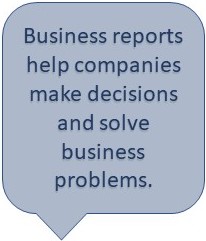Chapter 2: Reports
Learning Objectives
 After studying this unit, you will be able to
After studying this unit, you will be able to
-
-
- understand the purpose of reports
- understand report organization
- identify different types of reports
- identify the parts and contents of reports
- construct different types of reports
-
Introduction
 A vital part of any business or organization, reports document specific information for specific audiences, goals, or functions. The type of report is often identified by its primary purpose or function, as in an accident report, a laboratory report, a sales report, or even a book report.
A vital part of any business or organization, reports document specific information for specific audiences, goals, or functions. The type of report is often identified by its primary purpose or function, as in an accident report, a laboratory report, a sales report, or even a book report.
Reports are often analytical but sometimes just “report the facts” with no analysis at all. Other reports summarize past events, present current data, and forecast future trends. While a report may have conclusions, propositions, or even calls to action, presenting analysis is the primary function. A sales report, for example, is not designed to make an individual sale. It is, however, supposed to report sales to date and may forecast future sales based on previous trends [1].
Before delving into reports in detail, let’s review the advantages, disadvantages, and occasions for writing them.
| Channel | Advantages | Disadvantages | Expectations | Appropriate Use |
| Report | Allows presentation of a high volume of information presenting research and analysis | Time-consuming to write with proper research documentation and visual content | Follow conventions for organizing information according to the size of the report, audience, and purpose | For providing thorough business intelligence on topics important to an organization’s operation |
| Can take various forms such as a document booklet or proposal for reading alone | Time-consuming for the busy professional to read or an audience to take in | Visual aids should be covered in the text | For persuading audiences with well-developed arguments (e.g., recommendation reports) | |
| For persuading audiences with well-developed arguments (e.g., recommendation reports) |
Exercises
 1. Find an annual report for a business you would like to learn more about. Write a review for it and share it with classmates.
1. Find an annual report for a business you would like to learn more about. Write a review for it and share it with classmates.
2. Write a report on a trend in business that you’ve observed. For example, write a report recommending open textbooks as a solution to the rising cost of traditional textbooks being a significant issue for students.
References
Cember, E., Heavilon, A., Seip, M., Shi, L., & Brizee, A. (2018, March 23). Handbook on report formats. Purdue OWL. Retrieved from https://owl.english.purdue.edu/owl/resource/726/1/
Driscoll, D. L. (2013, March 12). Writing report abstracts. Purdue OWL. Retrieved from https://owl.english.purdue.edu/owl/resource/656/1/
Purdue OWL. (2010, April 29). Reports, proposals, and technical papers [PowerPoint File]. Retrieved from https://owl.english.purdue.edu/owl/resource/656/02/
Microsoft Office. (2014, December 14). Papers and Reports. Templates. Retrieved from https://templates.office.com/en-us/Papers-and-Reports
Techwriter. (2010, September 24). How to write a transmittal or cover letter. Technical Communication Centre. Retrieved from https://www.technicalcommunicationcenter.com/2010/09/24/how-to-write-a-transmittal-or-cover-letter/
University of South Australia. (2017). Study Help: Report writing [Video file]. Retrieved from https://www.youtube.com/watch?v=GV4yMF8vx6o
Chapter 11 Reports in Communication @ Work Seneca Edition.

